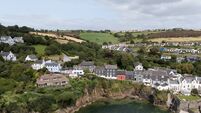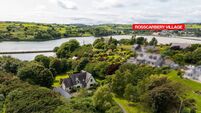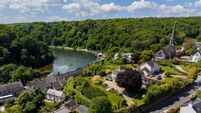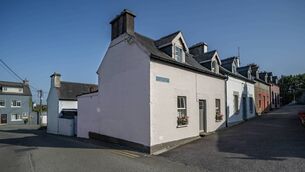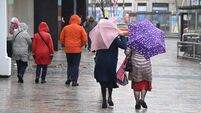Waterford is taking its cues from Bilbao

BLAME Frank Gehry and the Guggenheim in Bilbao but the concept of a museum breathing new life into a former industrial city has become something of a cliché.
In many respects, Waterford is similar to Bilbao, a proud port city attempting regeneration in the wake of the annihilation of manufacturing jobs.
However, when it came to building a new museum for the city, the council eschewed the services of star architects, keeping the design in-house.
The resulting Medieval Museum has been a huge success, becoming a cultural magnet for visitors and garnering a host of national and international architectural awards, including the RIAI’s Best Public Building, and making a place on the shortlist for the prestigious Mies Van der Rohe award for European architecture, won last week by the 1,000-seat Philarmonic Hall in Szczecin, Poland.

Waterford’s Medieval Museum is a cornerstone of the city’s Viking Triangle, which was borne out of a confluence of events, including the closure of the Waterford Crystal factory.
In 2007, Irish cities were asked to submit proposals under the Government’s Gateway Innovation Fund. One component of Waterford’s proposal was the Viking Triangle, which planned to develop the historic core of Ireland’s oldest city.
Rupert Maddock, one of the architects on the project, says intervention was badly needed. “The historic core wasn’t doing anything for the city at the time, there was a fair bit of dereliction and decay. It was clear some direction was needed. The basic concept was a culturally-led urban renewal and renaissance strategy for the historic core.
“The museum was down in Hanover Street, and the idea was to take that and bring it up to the Viking Triangle, to split it into three new museums relating to the artefacts that went into each. At the heart of it was trying to consolidate what the city had to show, rather than spreading it out. The Waterford Crystal closure happened shortly afterward.”

What was a devastating blow for the city did, however, present an opportunity when it was decided to locate a showroom and small manufacturing facility in former ESB offices on The Mall, just a short distance from the planned Viking Triangle. However, the circumstances of the closure meant action had to be taken quickly.
“There was real urgency to do something to save the brand, and the activity [of glassmaking] as part of the city fabric. It happened very quickly, decisions were made and a feasibility study was done,” says Rupert Maddock.
“That’s when the whole thing gelled — renovating the ESB building, creating offices for the council, using the ground floor for Waterford Crystal, and then using the 19th century buildings at the back for the visitor experience, as part of a composite development.
"Those strategic decisions were made within three or four months, and then we designed the building, got it through planning, so it was done literally within nine months.”
When so many public projects are beset by delays and spending overruns, this was a significant achievement, with collaboration a key element.

“The speed and efficiency with which the council operated is one of the things I’d be most proud of. Everybody worked together, they realised it was important for the city. Work began on site in January [2010] and the factory duly opened early in June.
“It was a very interesting period because it was the depths of the recession but we were busy. We went from doing the ESB building to the Bishops Palace, then the Medieval Museum.”
No time was wasted in the development of the museum with the design and build taking in the region of 18 months. Maddock says it was a once-in-a-lifetime opportunity.
“The site was so complex, there was archaeology, dereliction, conservation buildings, active use all around, a theatre, access issues, proximity to the cathedral — so many negatives that commercially it probably would never have been viable.
“The site was shoehorned around the side of the cathedral, it’s not like a museum facing onto a grand square or anything. The ends of the building were what we had to emphasise, what faced onto Cathedral Square and the Mall.
"They in a sense were advertising the building … all those unique conditions of the site were inevitably going to lead to a unique solution.”
He says keeping the project in-house made it easier to deal with the complex issues that arose. “We were able to bring all the disciplines within the council to bear — the fire officer, conservation officer, most importantly the museum director (Eamonn McEneaney) and his staff.
Everyone worked hand in glove and we were able to handle problems and deal with things in a way that would have been hard for an outside consultant to manage.”
The building cost in the region of €3.5 million, which by European standards is not expensive.
“There were other costs for the development works, archaeology, and so on and the overall cost probably came to around €6million,” says Maddock.
The feedback from visitors to the museum has been hugely positive.
“It’s almost like people like to see a building that’s different from their day to day experience, it’s transformative, almost like a theatrical experience. The building asserts itself as a contemporary intervention, but is respectful to its surroundings as well. We had to find that balance.”
While the Viking Triangle has provided a huge boost to the city, Waterford’s retail core has suffered greatly from lack of investment as development came to a virtual standstill in the last two decades. This is the next area to be tackled in the city’s regeneration, says Maddock.
“The general idea of the Viking Quarter is that you’re spreading west into the retail core — the idea of high-quality public ground which is designed for ease of movement for pedestrians as much as cars. Ultimately what’ll happen is the two will merge.
"They’ll keep their character — you need a name like the Viking Triangle as a marketing tool but there’s no line on the ground there, it’s a continuum.
“I could see Waterford develop along the lines of Dubrovnik — it has a sense of coherency, unified, within the original walls of the city area.”






